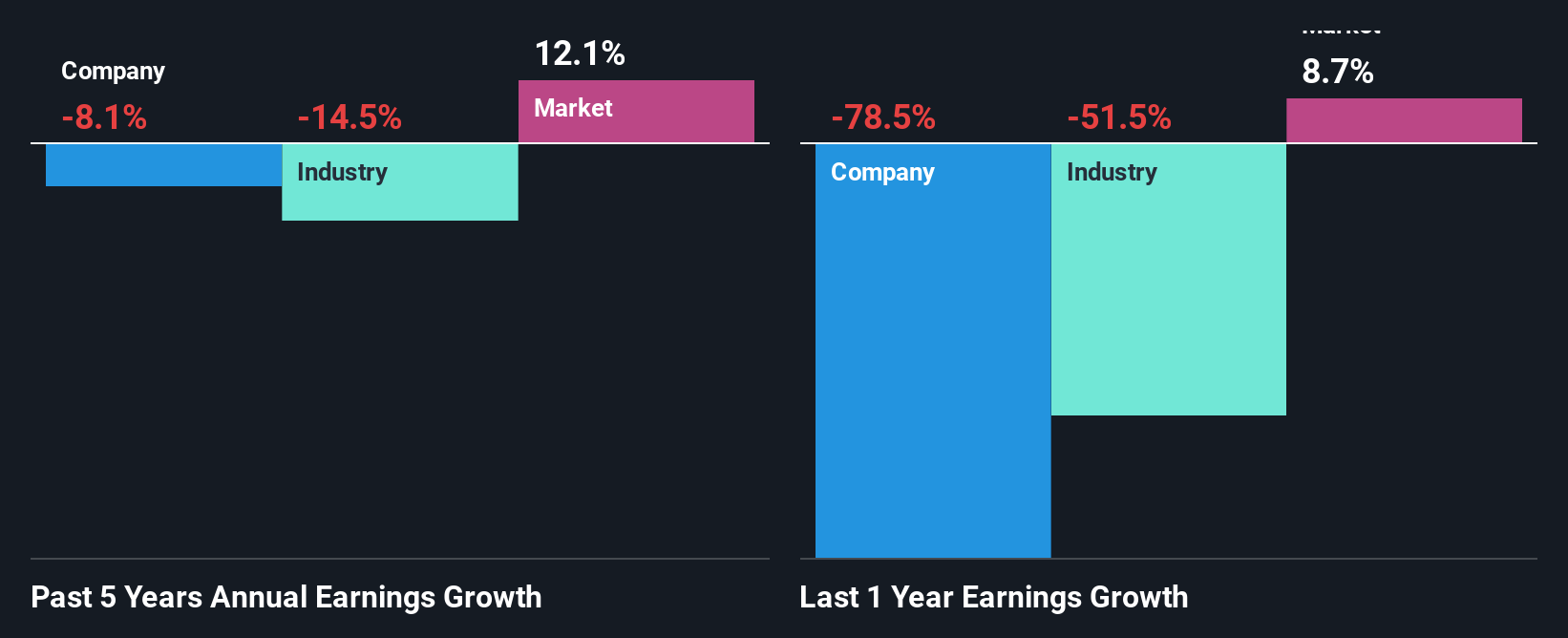- Saudi Arabia
- /
- Chemicals
- /
- SASE:2310
Sahara International Petrochemical Company's (TADAWUL:2310) Dismal Stock Performance Reflects Weak Fundamentals
Sahara International Petrochemical (TADAWUL:2310) has had a rough week with its share price down 5.8%. We decided to study the company's financials to determine if the downtrend will continue as the long-term performance of a company usually dictates market outcomes. In this article, we decided to focus on Sahara International Petrochemical's ROE.
ROE or return on equity is a useful tool to assess how effectively a company can generate returns on the investment it received from its shareholders. In other words, it is a profitability ratio which measures the rate of return on the capital provided by the company's shareholders.
How Do You Calculate Return On Equity?
Return on equity can be calculated by using the formula:
Return on Equity = Net Profit (from continuing operations) ÷ Shareholders' Equity
So, based on the above formula, the ROE for Sahara International Petrochemical is:
1.2% = ر.س194m ÷ ر.س16b (Based on the trailing twelve months to June 2025).
The 'return' is the profit over the last twelve months. Another way to think of that is that for every SAR1 worth of equity, the company was able to earn SAR0.01 in profit.
View our latest analysis for Sahara International Petrochemical
What Is The Relationship Between ROE And Earnings Growth?
So far, we've learned that ROE is a measure of a company's profitability. Depending on how much of these profits the company reinvests or "retains", and how effectively it does so, we are then able to assess a company’s earnings growth potential. Assuming all else is equal, companies that have both a higher return on equity and higher profit retention are usually the ones that have a higher growth rate when compared to companies that don't have the same features.
A Side By Side comparison of Sahara International Petrochemical's Earnings Growth And 1.2% ROE
It is quite clear that Sahara International Petrochemical's ROE is rather low. Even compared to the average industry ROE of 6.4%, the company's ROE is quite dismal. For this reason, Sahara International Petrochemical's five year net income decline of 8.1% is not surprising given its lower ROE. We reckon that there could also be other factors at play here. For example, the business has allocated capital poorly, or that the company has a very high payout ratio.
Next, we compared Sahara International Petrochemical's performance against the industry and found that the industry shrunk its earnings at 15% in the same period, which suggests that the company's earnings have been shrinking at a slower rate than its industry, This does offer shareholders some relief

Earnings growth is an important metric to consider when valuing a stock. It’s important for an investor to know whether the market has priced in the company's expected earnings growth (or decline). This then helps them determine if the stock is placed for a bright or bleak future. Is Sahara International Petrochemical fairly valued compared to other companies? These 3 valuation measures might help you decide.
Is Sahara International Petrochemical Using Its Retained Earnings Effectively?
Sahara International Petrochemical's high three-year median payout ratio of 130% suggests that the company is depleting its resources to keep up its dividend payments, and this shows in its shrinking earnings. Its usually very hard to sustain dividend payments that are higher than reported profits. You can see the 3 risks we have identified for Sahara International Petrochemical by visiting our risks dashboard for free on our platform here.
Moreover, Sahara International Petrochemical has been paying dividends for at least ten years or more suggesting that management must have perceived that the shareholders prefer dividends over earnings growth. Upon studying the latest analysts' consensus data, we found that the company's future payout ratio is expected to drop to 101% over the next three years. Accordingly, the expected drop in the payout ratio explains the expected increase in the company's ROE to 7.2%, over the same period.
Conclusion
Overall, we would be extremely cautious before making any decision on Sahara International Petrochemical. Specifically, it has shown quite an unsatisfactory performance as far as earnings growth is concerned, and a poor ROE and an equally poor rate of reinvestment seem to be the reason behind this inadequate performance. Having said that, looking at current analyst estimates, we found that the company's earnings growth rate is expected to see a huge improvement. To know more about the company's future earnings growth forecasts take a look at this free report on analyst forecasts for the company to find out more.
New: Manage All Your Stock Portfolios in One Place
We've created the ultimate portfolio companion for stock investors, and it's free.
• Connect an unlimited number of Portfolios and see your total in one currency
• Be alerted to new Warning Signs or Risks via email or mobile
• Track the Fair Value of your stocks
Have feedback on this article? Concerned about the content? Get in touch with us directly. Alternatively, email editorial-team (at) simplywallst.com.
This article by Simply Wall St is general in nature. We provide commentary based on historical data and analyst forecasts only using an unbiased methodology and our articles are not intended to be financial advice. It does not constitute a recommendation to buy or sell any stock, and does not take account of your objectives, or your financial situation. We aim to bring you long-term focused analysis driven by fundamental data. Note that our analysis may not factor in the latest price-sensitive company announcements or qualitative material. Simply Wall St has no position in any stocks mentioned.
About SASE:2310
Sahara International Petrochemical
Owns, establishes, operates, and manages industrial projects related to chemical and petrochemical industries in the Kingdom of Saudi Arabia.
Flawless balance sheet with reasonable growth potential.
Similar Companies
Market Insights
Community Narratives



